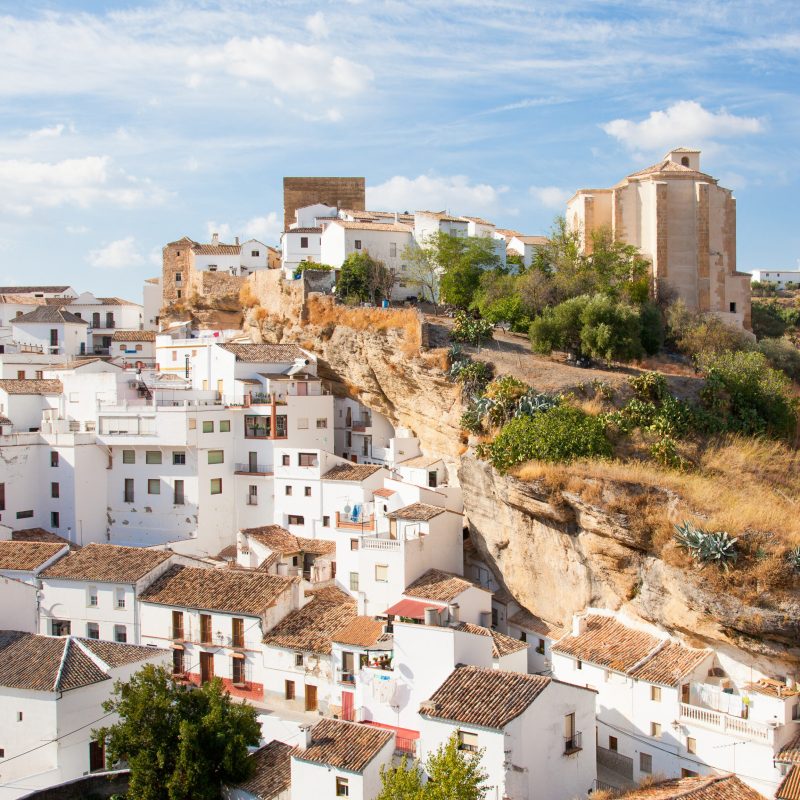
If you have a thing for unique places, cave dwellings, and beautiful scenic towns rich with history, Setenil de las Bodegas belongs on your bucket list. The unusual town, dating back multiple centuries, isn’t the most well-known destination in Spain, but it is one of the more unique experiences you could have while enjoying the wine and honey of the region.
Videos by TravelAwaits

What Makes Setenil De Las Bodegas So Unique?
As you walk the streets of this small town — population 2,700 as of 2018 — you’ll naturally look up to take in the unique way in which the city was built. Think whitewashed walls, rock ceilings, and narrow streets situated beneath canopies of stone.
The unique city in Andalucia was named for its once-flourishing wineries — also known as bodegas — and referred to as one of the pueblos blancos, or white villages, of Andalucia. Other pueblos blancos are built with protective bluffs as their shielding from potential attack, but Senetil grew out of a network of caves in the cliffs above Rio Trejo, northwest of the more well-known city of Ronda.
The houses and buildings of the small city look as though they’ve grown out of the rocks. Many have rock roofs and some even have olive groves on their roofs. A second “layer” of the city is built atop the rock, adding to Setenil de las Bodegas’s unique structure.

Why Was The Town Built This Way?
Odd as it may sound, the people who came to the area chose to settle into the rocky terrain for practical reasons. The natural caves were ideal living quarters that provided numerous benefits. The most obvious is the natural defense of, well, living in a cave. But the way the buildings are constructed also provides natural cooling in summer and warmth in the wintertime. They simply built facades into the rock to enclose their home spaces and eventually create a village.

When Should You Visit Setenil De Las Bodegas?
There are two ideal times to visit the Cadiz province in which Setenil De Las Bodegas is situated. From mid-March to early July and early September to late November you’ll be met with the most pleasant temperatures in this semi-temperate area. The driest time to visit — that is, the season with the least rainfall — is June through August. So if you prefer a dry, hot vacation to a cooler, damper one, a summer trip to Setenil de las Bodegas will be best.

Must-See Places In And Around This Unusual Town
Just walking through the city, looking at the unique structures, and passing through its narrow streets could take a good portion of the day. The unique placement of buildings and views of the rocks used as roofs will keep you busy. But some specific stops you’ll want to make within the town’s limits include a wide range of bars, restaurants — Bar La Escueva is a particularly popular spot for tapas — and other food establishments that are considered some of the finest in the region. The area is famous for chorizo, olive oil, jam, honey, and Andalusian wines.
The Moorish castle, Castillo de Setenil de las Bodegas, or Nazari Castle, is a definite must-see. It’s located within the town center, next to the Church of Our Lady of Incarnation. The castle was built during the Arab occupation between the 12th and 13th centuries and was once considered the bastion of defense for the town. The Church of Our Lady of Incarnation is also an important historical site filled with the intrigue of a city dating back to the late 1400s. Some records housed in the church are said to date back even further — at least 2,000 years.
Even the tourist center is a unique experience, housed in a medieval building with a beautifully crafted Moorish wooden ceiling.
While you’re exploring the area, there are several things you’ll want to experience. Outside the town — about five miles away — you can explore ancient Roman ruins from the first century A.D. You can also visit Bodega Las Monjas, a former nunnery that produces Principe Alfonso, some of the region’s finest red wine.

How To Get There
There are a variety of ways to get to Setenil de las Bodegas. The quickest route is driving A-357 from Malaga. The road is curving around mountains, though, and rather narrow at places, so you may opt for less intimidating routes from Ronda or Teba, instead.
If you don’t mind public transportation or a moderate hike, you can take the train to the Setenil station, located a little over three miles outside of town. There are two trains each day coming in from Algeciras, Ronda, and Granada. The station is not manned, but you can purchase tickets from the train guard or online.
